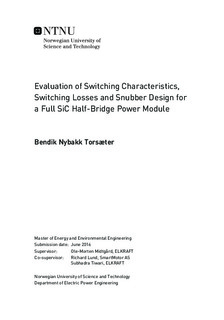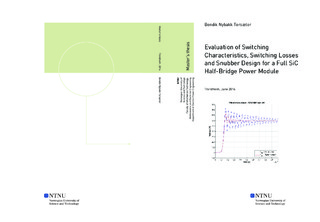| dc.description.abstract | In this thesis, the performance of the full Silicon Carbide (SiC) half-bridge power module BSM120D12P2C005 from Rohm Semiconductor is investigated. A laboratory circuit enabling double-pulse tests of the half-bridge module is designed and built. Building such a laboratory circuit demands careful analysis of the challenges and dangerous aspects that might arise. Consequently, the first part of the thesis discusses relevant background theory on SiC material properties, SiC MOSFETs and SiC SBDs. This is followed by general theory on different power converters, as well as analysis of switching transients and power losses in MOSFETs and SBDs. A theoretical efficiency comparison of three-phase inverters consisting of eight different state-of-the-art SiC half-bridge modules and one state-of-the-art Si IGBT half-bridge module is provided. It is shown in this comparison that all the SiC modules achieve an efficiency of 98 %, while the Si IGBT module gives an efficiency of approximately 93 % at 50 kHz.
Subsequently, general theory on important considerations when designing a converter circuit for hard-switching SiC modules is presented. This is followed by a detailed description of the laboratory setup, the measuring instruments and other important considerations in this thesis.
The next part presents an analysis of the SiC module performance through simulations in LTspice IV. The simulation circuit design and decisions are justified. The simulations are used as basis to investigate the switching characteristics of the SiC module, in addition to testing the impact of changes in the laboratory circuit. It is found through simulations that the combination of a DC snubber and a turn-off snubber could help improve the switching characteristics.
Finally, results from the laboratory experiments are presented. Firstly, it is shown that the bandwidth and stray inductance of the measuring instruments influence the switching characteristics. This is followed by a discussion on the selection of gate resistance and its influence on the switching speed. A short-circuit protection (SCP) is added to the gate driver of the SiC MOSFET, and its practical operation is proven successful. The switching characteristics and switching losses are obtained through double-pulse tests of the SiC MOSFET, and are presented for different drain-to-source voltages and drain currents. The switching characteristics show high switching stresses on the SiC module. Thus, snubber circuits are added to the laboratory circuit. The addition of a DC snubber and a turn-off snubber results in 40 % reduction in voltage overshoot and 85 % reduction in ringing duration. This improvement is achieved with an increase in total switching losses of 24 %. It is found that an Si IGBT switching at 600 V 120 A and a switching frequency of 50 kHz dissipates four times more energy than a SiC MOSFET including snubbers at equal conditions. | |

